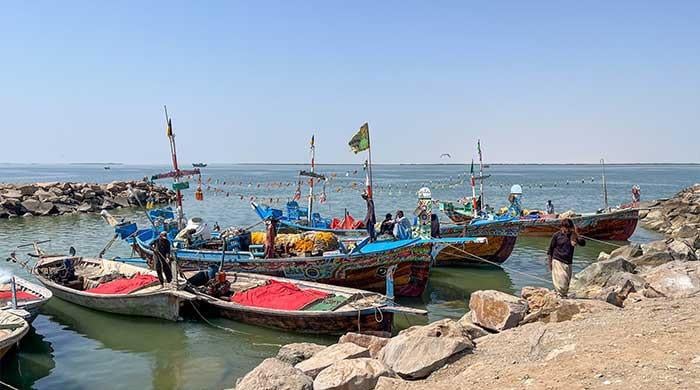Pakistan’s Marine Conservation Efforts: A Mirage?
Pakistan has officially initiated measures to conserve its marine environment. In July, the nation designated its third marine protected area (MPA) near Miani Hor, a marshy coastal lagoon situated roughly 100km west of Karachi. This designation follows those of Astola Island and Churna Island, established in 2017 and 2024, respectively. These zones are intended to serve as sanctuaries for coral reefs, diverse fish species, and various forms of marine life.
However, the reality within Pakistan’s MPAs presents a stark contrast. Trawlers drag along the seafloor, abandoned “ghost nets” ensnare marine organisms, and fishermen employ electric currents to stun their catches.
Pakistan has committed to safeguarding 30% of its oceanic territory by 2030. Currently, these three MPAs collectively encompass less than 1% of that goal.
Rab Nawaz, the senior director for biodiversity programs at WWF-Pakistan, points out that domestic conservation efforts are mostly land-based, fueled by growing awareness and vocal concerns. He fears that Pakistan’s marine environment is suffering neglect, leading to a decline in marine life due to poorly regulated development and the impacts of climate change.
Oceanic well-being is crucial for human survival, as oceans generate half of the Earth’s oxygen and absorb around 25% of human-caused CO2 emissions. They also store an estimated 91% of the excess heat trapped within the planet’s climate system due to increased greenhouse gases.
Pakistan, as a signatory to the UN Convention on Biological Diversity, adopted the Kunming-Montreal Global Biodiversity Framework (GBF) in 2022, setting targets to conserve at least 30% of terrestrial and inland water areas, as well as 30% of marine and coastal zones, by 2030.
With the deadline fast approaching, progress towards this “30×30” objective has been inconsistent.
Experts note that Pakistan’s three MPAs cover only 1,262 sq km out of the 240,000 sq km of ocean under its jurisdiction (0.5%). This deficiency is common in South Asia, where many biodiversity convention signatories face similar challenges. Bangladesh has designated 8.0% of its marine areas as MPAs, India 0.3%, the Maldives less than 0.1%, and Sri Lanka 0.3%, according to SkyTruth, which monitors progress towards the 30×30 target.
Establishing MPAs in Pakistan has proven challenging, although the process itself is seemingly straightforward:
- Initial baseline studies are conducted in a potential area.
- Local residents, fishermen, and relevant government and authority stakeholders are consulted for their input.
- Proposals are submitted to a national coordinating body for evaluation and decision-making. This body includes representatives from various ministries, departments, civil society, and provincial wildlife authorities, and is chaired by the climate change ministry, with the IUCN acting as convener.
However, the process can be lengthy. For example, Miani Hor was initially proposed in 2013 but only materialized this year.
Following the national coordinating body’s decision, the relevant provincial government issues a formal MPA notification, delineating boundaries and protection measures, such as fishing restrictions.
The notifications for Churna and Miani MPAs outline intentions to protect and restore habitats, biodiversity, and ecological processes affected by human activities. They impose restrictions on harming endangered species and prohibit the use of explosives, chemicals, and certain types of fishing gear. Prior permission is required for recreational activities such as scuba diving and power boating.
Nevertheless, the enforcement of these protections is often lacking.
Astola Island, designated as an MPA in 2017, aimed to safeguard coastal biodiversity, including coral, turtles, and whales. The island’s waters also support the livelihoods of mainland fishermen who travel there regularly.
Abdul Ghafoor, a Pasni-based fisherman, expressed initial optimism that the MPA designation would curb activities that had depleted their catches, such as tourist camps, discarded fishing nets, and damaging trawlers.
However, disillusionment has since grown. Ghafoor laments the absence of protective measures, with ghost nets, plastics, and destructive tourism and trawling activities persisting.
While the Astola MPA notification restricted certain tourist activities, it did not explicitly prohibit trawling. A management plan, endorsed in April 2025, remains unimplemented, with no enforcement officers hired.
The Churna Island MPA, established last year, sought to protect local corals and fish threatened by over-tourism, an oil refinery development, and crude oil tanker operations.
Securing protection for Churna proved challenging due to its commercial value for the oil and tourism sectors, as well as political interests.
Shrifuddin Baloch highlights the significant opposition faced during the process. Despite these hurdles, Churna’s MPA designation was achieved through persistent efforts, activist and NGO support, and positive media coverage.
However, a year later, many locals report no tangible changes.
Sarfaraz Ali, a local government representative for Churna, says that while he heard about the protection measures, the specifics are unknown to villagers. Trawling, electric fishing, and coral damage by tourists continue unabated, without intervention from authorities.
Similar issues plague Miani Hor, selected for its diverse marine life. Khalil Ronjha, a local activist, notes the lack of awareness and understanding regarding the MPA designation among residents.
Officials attribute the shortcomings to funding deficits. Abdul Fateh Bhanger points out the environment departments receive minimal budgetary allocations.
Baloch echoes this concern, emphasizing the need for personnel and equipment to effectively monitor the areas, which the department lacks.
Baloch also notes that the department, established in 2021, oversees a broad network of protected areas and is responsible for controlling migratory bird poaching.
Dostain Jamaldini, a former director general, challenges the claim that funding is the primary obstacle, arguing that effective leadership is lacking.
Pakistan has protected 19.21% of its terrestrial areas and inland waters, according to Protected Planet, contrasting with its limited marine protection efforts.
Moriani states that the federal government is collaborating with provincial counterparts and international NGOs to establish additional MPAs, with feasibility studies underway in Sindh.
She also mentions the exploration of other effective area-based conservation measures (OECMs), which offer meaningful protection despite not being specifically dedicated to biodiversity.
As Pakistan considers its options for achieving the 30×30 goal, time is running out. The nation is far from reaching the Kunming-Montreal deadline with such a small portion of its marine territory under protection.



Comments (0)
No comments yet. Be the first to comment!
Leave a Comment